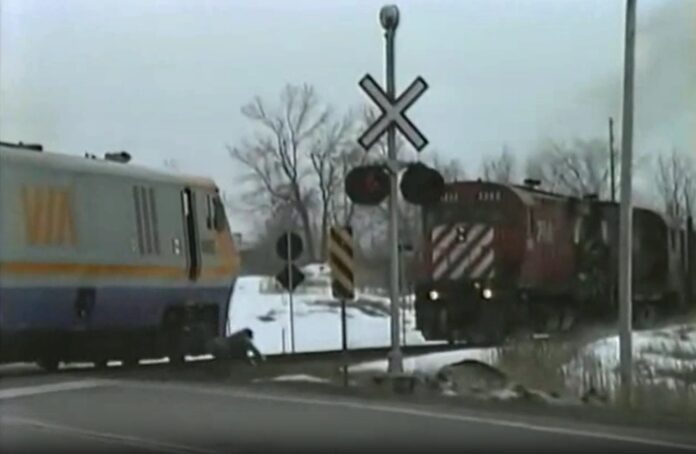
Have you ever heard of the near-collision of two trains in Smiths Falls in 1991? The incident may not have a well-known name (like the “Hinton Train Collision” of 1986, for example), but it was undoubtedly a terrifying incident and one that warranted a Transportation Safety Board investigation all the same. The close call is known officially by the TSB as “Canadian Pacific Limited and Via Rail Inc. near collision”, though a boring name certainly doesn’t mean a boring incident.
Trains are fascinating. Some people are certainly more obsessed than others. In fact, there is a huge population of the world that goes by the name of “railfans”, engaging in an activity called “railfanning” that involves waiting trackside to watch and photograph trains, in addition to learning all there is to know about these massive and historic machines which were critical in connecting and building our country beginning in the early 1800s.
Although very safe, trains do get involved in accidents as with any other mode of transportation. Most commonly, this involves trains hitting cars or pedestrians at level crossings, or derailments involving a single train. In a world full of inexpensive video filming technology (most people carry a smartphone with a camera right in their pocket, and dashcams are increasingly common in vehicles), it’s now possible to go online and see perhaps hundreds of videos of trains hitting vehicles, and even trains derailing suddenly at level crossings.
One of the things that makes the Smiths Falls incident of 1991 stand out is that it was filmed during a time when something rare being “caught on tape” was a big deal, being so uncommon and coincidental. I have not been able to find any source to explain why the incident was filmed, but it seems a safe assumption that a “railfan” was in the right place at the right time. This was an era where “videotaping” something quite literally meant using tape or film which had to be purchased (a bit of knowledge for younger readers), and filming trains would have been for personal enjoyment only since there was no social media on which to share them. The alternative explanation is that someone approaching the level crossing saw the potential for a collision and happened to have a camera on hand, managing to get it out and filming just in time!
What actually happened? It was February 6, 1991, two days before the five year anniversary of the Hinton Train Collision, which was a massive and deadly head-on collision between a Via Rail train and a CN freight train outside Hinton, Alberta on February 8, 1986. In the Smiths Falls incident, Via Rail train 43 was travelling from Ottawa to Toronto on a track owned by CN Railway. Smiths Falls has a large CP Railway yard as well, with a section of CP track that connects with CN track. A three-person CP crew was working to build a “consist” of train cars by moving around small groups of cars on various tracks to build a larger mainline train. At the critical point, the crew was moving 67 empty flatcars that had a total length of 4,423 feet. In order for the train to clear a switch, the crew needed to “back up” onto the CN line due to the length of their train. They didn’t make a radio call to confirm that the CN track was clear, and a signal that had been installed to protect the area was not yet operational.
What happened next happened very quickly but must have felt like a heart-stopping eternity for the crews of both trains. Via Rail train 43 was travelling at 93 mph (150 km/h) and had only 1.3 km of warning that the CP train was in its way since it was coming around a blind curve. The Via Rail crew applied the train’s emergency brakes, and then one engineer jumped from the train as it slowed down to avoid being inside the locomotive cab during what must have seemed like an inevitable collision. The CP Rail crew – whose train would have been at a crawling speed during a switching job – managed to stop their train and begin reversing. The extra track room meant that the Via Rail train was able to come to a stop just in time, and no collision occurred.
The CP train crew was certainly in the wrong for encroaching on the CN track without authorization, but had they not reversed, a collision would have occurred. Another key factor was the season – without leaves on the trees, the Via Rail crew was able to spot the CP train earlier, otherwise the emergency braking may not have been applied in time.
The Via Rail engineers did all they could by applying emergency braking. The decision by one engineer to jump was criticized by some, since his passengers did not have the same option. However, being in the cab during a head-on collision is certainly more dangerous than being in a passenger car, and the crew had already exhausted all their options. Regardless of the mistakes and decisions of the day, the only important thing is that the incident was only an “almost” collision.
Readers are encouraged to view the video of this fascinating incident of local railroading history at https://churcher.crcml.org/circle/Wreck%20Details/1991SmithsFallsNear.mp4.

